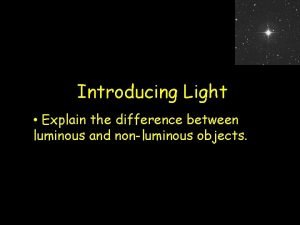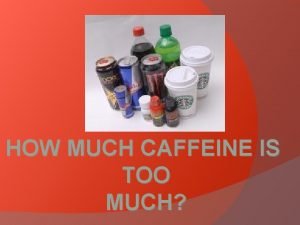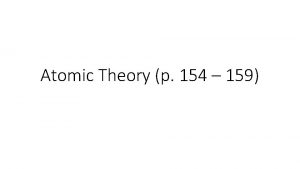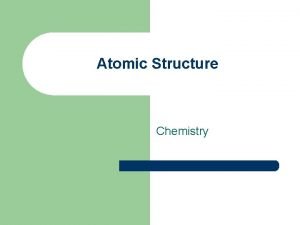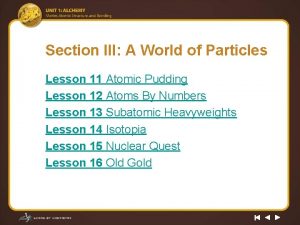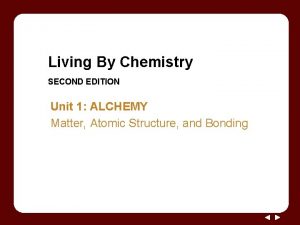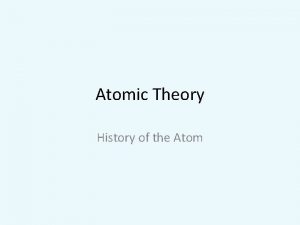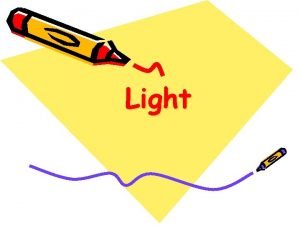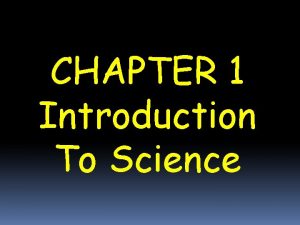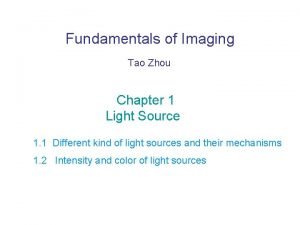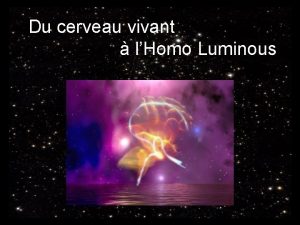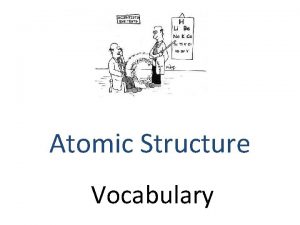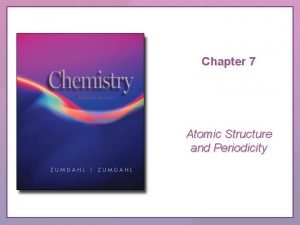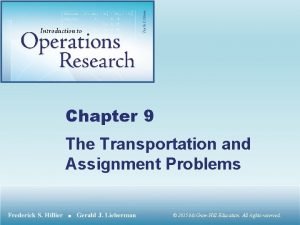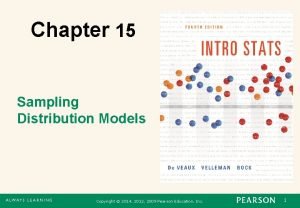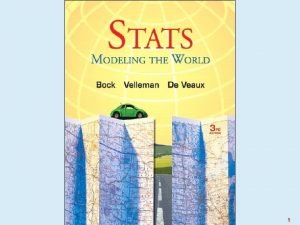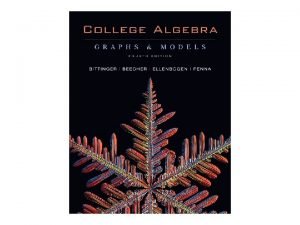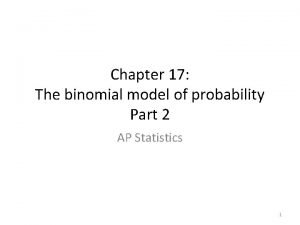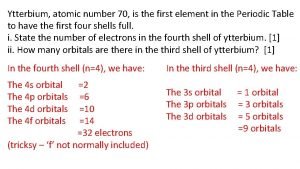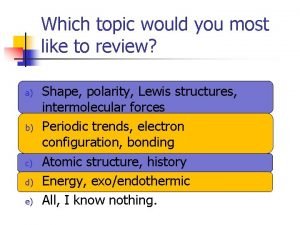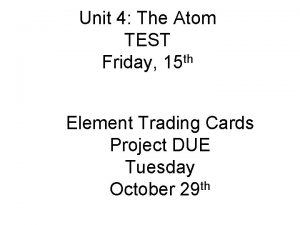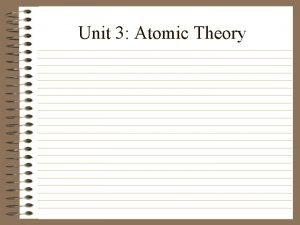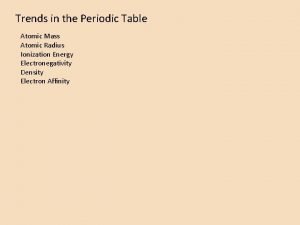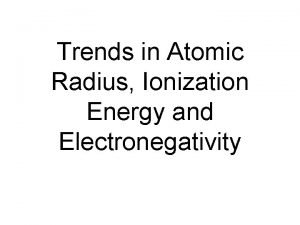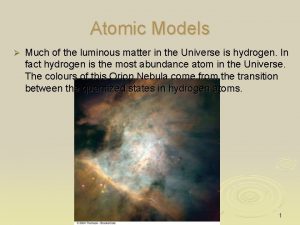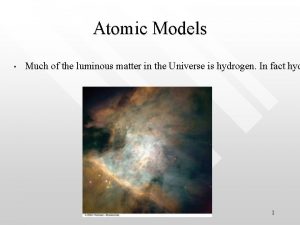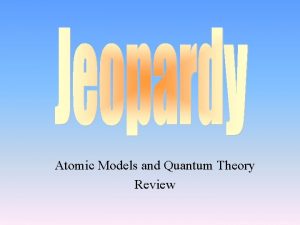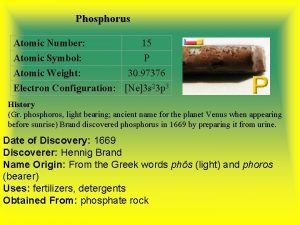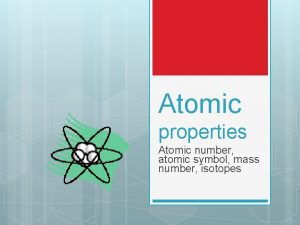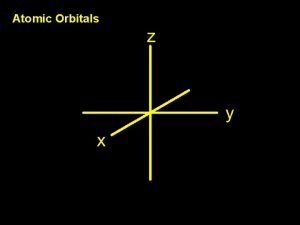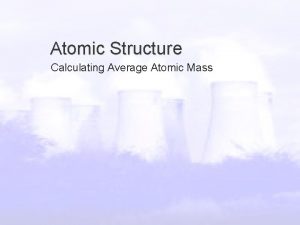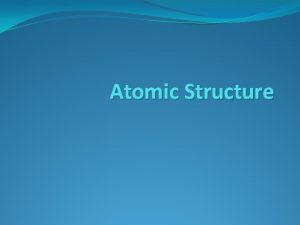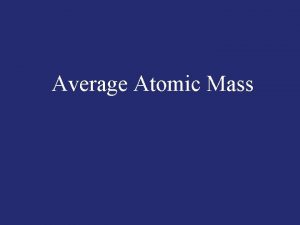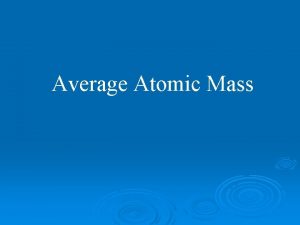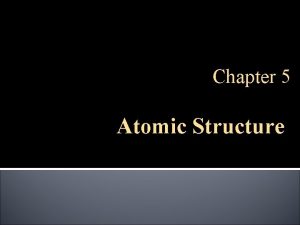CHAPTER 5 Atomic Models Much of the luminous




















































































- Slides: 84

CHAPTER 5 Atomic Models Much of the luminous matter in the Universe is hydrogen. In fact hydrogen is the most abundance atom in the Universe. The colours of this Orion Nebula come from the transition between the quantized states 1 in hydrogen atoms.

INTRODUCTION • • The purpose of this chapter is to build a simplest atomic model that will help us to understand the structure of atoms This is attained by referring to some basic experimental facts that have been gathered since 1900’s (e. g. Rutherford scattering experiment, atomic spectral lines etc. ) In order to build a model that well describes the atoms which are consistent with the experimental facts, we need to take into account the wave nature of electron This is one of the purpose we explore the wave nature of particles in previous chapters 2

Basic properties of atoms • • 1) Atoms are of microscopic size, ~ 10 -10 m. Visible light is not enough to resolve (see) the detail structure of an atom as its size is only of the order of 100 nm. 2) Most atoms are stable (i. e. atoms that are non radioactive) 3) Atoms contain negatively charges, electrons, but are electrically neutral. An atom with Z electrons must also contain a net positive charge of +Ze. 4) Atoms emit and absorb EM radiation (in other words, atoms interact with light quite readily) Because atoms interacts with EM radiation quite strongly, it is usually used to probe the structure of an atom. The typical of such EM probe can be found in the 3 atomic spectrum as we will see now

Emission spectral lines • • • Experimental fact: A single atom or molecule in a very diluted sample of gas emits radiation characteristic of the particular atom/molecule species The emission is due to the de-excitation of the atoms from their excited states e. g. if heating or passing electric current through the gas sample, the atoms get excited into higher energy states When a excited electron in the atom falls back to the lower energy states (de-excites), EM wave is emitted The spectral lines are analysed with spectrometer, which give important physical information of the atom/molecules by analysing the wavelengths composition and pattern of these lines. 4

Line spectrum of an atom • The light given off by individual atoms, as in a lowpressure gas, consist of a series of discrete wavelengths corresponding to different colour. 5

Comparing continuous and line spectrum • (a) continuous spectrum produced by a glowing light-bulb • (b) Emission line spectrum by lamp containing heated gas 6

Absorption line spectrum • We also have absorption spectral line, in which white light is passed through a gas. The absorption line spectrum consists of a bright background crossed by dark lines that correspond to the absorbed wavelengths by the gas atom/molecules. 7

Experimental arrangement for the observation of the absorptions lines of a sodium vapour 8

Comparing emission and absorption spectrum The emitted and absorption radiation displays characteristic di (a) shows ‘finger print’ emission spectral lines of H, Hg and N 9

A successful atomic model must be able to explain the observed discrete atomic spectrum We are going to study two attempts to built model that describes the atoms: the Thompson Plum-pudding model (which fails) and the Rutherford-Bohr model (which succeeds) 10

The Thompson model – Plumpudding model Sir J. J. Thompson (1856 -1940) is the Cavandish professor in Cambridge who discovered electron in cathode rays. He was awarded Nobel prize in 1906 for his research on the conduction of electricity by bases at low pressure. He is the first person to establish the particle nature of electron. Ironically his son, another renown physicist proves experimentally electron behaves like wave… 11

Plum-pudding model • • • An atom consists of Z electrons is embedded in a cloud of positive charges that exactly neutralise that of the electrons’ The positive cloud is heavy and comprising most of the atom’s mass Inside a stable atom, the electrons sit at their respective equilibrium position where the attraction of the positive cloud on the electrons balances the electron’s mutual repulsion 12

One can treat the electron in the pudding like a point mass stressed by two springs SHM 13

The “electron plum” stuck on the pudding vibrates and executes SHM • The electron at the EQ position shall vibrate like a simple harmonic oscillator with a frequency • Where , R radius of the atom, m mass of the electron From classical EM theory, we know that an oscillating charge will emit radiation with frequency identical to the oscillation frequency n as given above • 14

The plum-pudding model predicts unique oscillation frequency • • • Radiation with frequency identical to the oscillation frequency. Hence light emitted from the atom in the plumpudding model is predicted to have exactly one unique frequency as given in the previous slide. This prediction has been falsified because observationally, light spectra from all atoms (such as the simplest atom, hydrogen, ) have sets of discrete spectral lines correspond to many different frequencies (already discussed earlier). 15

Experimental verdict on the plum pudding model • • • Theoretically one expect the deviation angle of a scattered particle by the plum-pudding atom to be small: This is a prediction of the model that can be checked experimentally Rutherford was the first one to carry out such experiment 16

Ernest Rutherford British physicist Ernest Rutherford, winner of the 1908 Nobel Prize in chemistry, pioneered the field of nuclear physics with his research and development of the nuclear theory of atomic structure Born in New Zealand, teachers to many physicists who later become Nobel prize laureates Rutherford stated that an atom consists largely of empty space, with an electrically positive nucleus in the center and electrically negative electrons orbiting the nucleus. By bombarding nitrogen gas with alpha particles (nuclear particles emitted through radioactivity), Rutherford engineered the transformation of an atom of nitrogen into both an atom of oxygen and an atom of hydrogen. This experiment was an early stimulus to the development of nuclear energy, a form of energy in which nuclear transformation and disintegration release extraordinary power. 17

Rutherford’s experimental setup • • Alpha particles from source is used to be scattered by atoms from the thin foil made of gold The scattered alpha particles are detected by the background screen 18

“…fire a 15 inch artillery shell at a tissue paper and it came back and hit you” • • • In the scattering experiment Rutherford saw some electrons being bounced back at 180 degree. He said this is like firing “a 15 -inch shell at a piece of a tissue paper and it came back and hit you” Hence Thompson plum-pudding model fails in the light of these experimental result 19

So, is the plum pudding model utterly useless? • • • So the plum pudding model does not work as its predictions fail to fit the experimental data as well as other observations Nevertheless it’s a perfectly sensible scientific theory because: It is a mathematical model built on sound and rigorous physical arguments It predicts some physical phenomenon with definiteness It can be verified or falsified with experiments It also serves as a prototype to the next model which is built on the experience gained from the failure of this model 20

to interpret the Rutherford scattering experim • The large deflection of alpha particle as seen in the scattering experimen • In contrast, a diffused distribution of the positive charge as assumed in p 21

Comparing model with nucleus concentrated at a point-like nucleus and model with nucleus that has large size 22

Recap the atomic model building story • • • Plum-pudding model by Thompson It fails to explain the emission and absorption line spectrum from atoms because it predicts only a single emission frequency Most importantly it fails to explain the back-scattering of alpha particle seen in Rutherford’s scattering experiment because the model predicts only 23

• • • The Rutherford model (planetary model) Rutherford put forward an model to explain the result of the scattering experiment: the Rutherford model An atom consists of a very small nucleus of charge +Ze containing almost all of the mass of the atom; this nucleus is surrounded by a swarm of Z electrons The atom is largely comprised of empty space Ratom ~ 10 -10 m Rnucleus ~ 10 -13 - 10 -15 m 24

d catastrophe: insufficiency of the Rutherford • • According to classical EM, the Rutherford model for atom (a clas A accelerated electron will radiate EM radiation, hence causing th 25

Rutherford model also can’t explain the discrete spectrum • The Rutherford model also cannot explain the pattern of discrete spectral lines as the radiation predicted by Rutherford model is a continuous burst. 26

So how to fix up the problem? NEILS BOHR COMES TO THE RESCUE • • • Niels Bohr (1885 to 1962) is best known for the investigations of atomic structure and also for work on radiation, which won him the 1922 Nobel Prize for physics He was sometimes dubbed “the God Father” in the physicist community http: //www-gap. dcs. stand. ac. uk/~history/Mathematicians/ Bohr_Niels. html 27

To fix up the infrared catastrophe … Neils Bohr put forward a model which is a hybrid of the Rutherford model with the wave nature of electron taken into account 28

Bohr’s model of hydrogen-like atom • • • We shall consider a simple atom consists of a nucleus with charge Ze and mass of Mnucleus >> me, such that (me /Mnucleus) can be ignored. The nucleus is surrounded by only a M >>m single electron We will assume the centre of the +Ze circular motion of the electron coincides with the centre of the nucleus We term such type of simple system: hydrogen-like atoms Diagram representing For example, hydrogen atom the model of a corresponds to Z = 1; a singly hydrogen-like atom + ionised Helium atom He corresponds to Z = 2 etc 29

Bohr’s postulate, 1913 • • Postulate No. 1: Mechanical stability (classical mechanics) An electron in an atom moves in a circular orbit about the nucleus under Coulomb attraction obeying the law of classical mechanics +Ze Coulomb’s attraction = centripetal force Assumption: the mass of the nucleus is infinitely heavy compared to the electron’s 30

Postulate 2: condition for orbit stability • • Instead of the infinite orbit which could be possible in classical mechanics (c. f the orbits of satellites), it is only possible for an electron to move in an orbit that contains an integral number of de Broglie wavelengths, nln = 2 p rn, n = 1, 2, 3. . . 31

that n de Broglie wavelengths must fit into th 32

Electron that don’t form standing wave • • • Since the electron must form standing waves in the orbits, the orbits of the electron for each n is quantised Orbits with the perimeter that do not conform to the quantisation condition cannot persist All this simply means: all orbits of the electron in the atom must be quantised, and orbit that is not quantised is not allowed (hence can’t exist) 33

Quantisation of angular momentum • • • As a result of the orbit quantisation, the angular momentum of the orbiting electron is also quantised: L = (mev) r = pr (definition) nl = 2 p r (orbit quantisation) Combining both: p= h/l = nh/ 2 p r L = mevr = p r = nh/ 2 p +Ze p = mv Angular momentum of the electron, L = p x r. It is a vector quantity with its direction pointing to the direction perpendicular to the plane defined by p and r 34

Third postulate • • • Despite the fact that it is constantly accelerating, an electron moving in such an allowed orbit does not radiate EM energy (hence total energy remains constant) As far as the stability of atoms is concerned, classical physics is invalid here My Comment: At the quantum scale (inside the atoms) some of the classical EM predictions fail (e. g. an accelerating charge radiates EM wave) 35

Quantisation of velocity and radius • • Combining the quantisation of angular momentum and the equation of mechanical stability we arrive at the result that: the allowed radius and velocity at a given orbit are also quantised: 36

Some mathematical steps leading to quantisation of orbits, Ø(Eq. 2) (Eq. 1)2, = (nh/ 2 p)2 ØLHS: me 2 r 2 v 2 = me 2 r 2 (Ze 2 / 4 pe 0 me r) = me r Ze 2 / 4 pe 0 = RHS = (nh/ 2 p)2 r = n 2(h/ 2 p)2 4 pe 0 / Ze 2 me ≡ rn , n = 1, 2, 3… Ø(mevr)2 37

Prove it yourself the quantisation of the electron velocity using Eq. (1) and Eq. (2) 38

The quantised orbits of hydrogenlike atom (not to scale) +Ze r 0 r 4 r 3 r 2 39

Important comments • • • The smallest orbit charaterised by Z = 1, n=1 is the ground state orbit of the hydrogen It’s called the Bohr’s radius = the typical size of an atom In general, the radius of an hydrogen-like ion/atom with charge Ze in the nucleus is expressed in terms of the Bohr’s radius as Note also that the ground state velocity of the electron in the hydrogen atom is m/s << c non-relativistic 40

PYQ 7 Test II 2003/04 • In Bohr’s model for hydrogen-like atoms, an electron (mass m) revolves in a circle around a nucleus with positive charges Ze. How is the electron’s velocity related to the radius r of its orbit? A. B. C. • D. • Solution: I expect you to be able to derive it from scratch without memorisation ANS: D, Schaum’s series 3000 solved problems, Q 39. 13, pg 722 modified • • E. Non of the above 41

Strongly recommending the Physics 2000 interactive physics webpage by the University of Colorado For example the page http: //www. colorado. edu/physics/2000/quantu mzone/bohr. html provides a very interesting explanation and simulation on atom and Bohr model in particular. Please visit this page if you go online 42

Recap • The hydrogen-like atom’s radii are quantised according to: +Ze • • The quantisation is a direct consequence of the postulate that electron wave forms stationary states (standing waves) at the allowed orbits The smallest orbit or hydrogen, the Bohr’s radius 43

Postulate 4 • Similar to Einstein’s postulate of the energy of a photon EM radiation is emitted if an electron initially moving in an orbit of total energy Ei, discontinuously changes it motion so that it moves in an orbit of total energy Ef, (Ei > Ef). The frequency of the emitted radiation, n = (Ei - Ef)/h; Ei > Ef 44

Energies in the hydrogen-like atom • Potential energy of the electron at a distance r from the nucleus is, as we learned from standard electrostatics, ZCT 102, form 6, matriculation etc. is simply • -ve means that the EM force is attractive Check this sign to see if it’s correct +Ze Fe -e 45

Kinetic energy in the hydrogen-like atom • According to definition, the KE of the electron is The last step follows from the equation • Adding up KE + V, we obtain the total mechanical energy of the atom: 46

The ground state energy • For the hydrogen atom (Z = 1), the ground state energy (which is characterised by n =1) In general the energy level of a hydrogen like atom with Ze nucleus charges can be expressed in terms of 47

Quantisation of energy levels • • • The energy level of the electrons in the atomic orbit is quantised The quantum number, n, that characterises the electronic states is called principle quantum number Note that the energy state is –ve (because it’s a bounded system) 48

Energy of the electron at very large n • An electron occupying an orbit with very large n is “almost free” because its energy approaches zero: • E = 0 means the electron is free from the bondage of the nucleus’ potential field Electron at high n is not tightly bounded to the nucleus by the EM force Energy levels at high n approaches to that of a continuum, as the energy gap between adjacent energy levels become infinitesimal in the large n limit • • 49

Ionisation energy of the hydrogen atom • • The energy input required to remove the electron from its ground state to infinity (ie. to totally remove the electron from the bound of the nucleus) is simply this is the ionisation energy of hydrogen E=E 0=-13. 6 e. V +Ze Fe -e Ionisation energy to pull the electron off from the attraction of the +ve nucleus + -e +Ze Free electron (= free from the attraction of 50 the +ve nuclear charge, E= 0)

Two important quantities to remember • As a practical rule, it is strongly advisable to remember the two very important values • (i) the Bohr radius, r 0 = 0. 53 A and (ii) the ground state energy of the hydrogen atom, E 0 = -13. 6 e. V • 51

Bohr’s 4 th postulate explains the line spectrum When atoms are excited to an energy sta • • When a beam of light with a range of wavelength sees an atom, the few particular wavelengths that matches the allowed energy gaps of the atom will be absorbed, leaving behind other unabsorbed wavelengthsto become the bright background in the absorption spectrum. Hence absorption spectrum explained 52

Balmer series and the empirical emission spectrum equation • Since 1860 – 1898 Balmer have found an empirical formula that correctly predicted the wavelength of four visible lines of hydrogen: Hb n H n=5 n=4 n=3 Ha n=6 Hg Hd where n = 3, 4, 5, …. RH is called the Rydberg constant, experimentally measured to be RH = 1. 0973732 x 107 m-1 53

Example • For example, for the Hb (486. 1 nm) line, n = 4 in the empirical formula • According to the empirical formula the wavelength of the hydrogen beta line is • which is consistent with the observed value 54

Experimental measurement of the Rydberg constant, RH One measures the wavelengths of the a, b, g, …lines (corresponding to n = 3, 4, 5, … ) in Balmer’s empirical formula Then plot 1/l as a function of 1/n 2. Note that here n 3. Balmer’s 1/l series limit g line b line Intersection of the experimental line with 1/l axis = RH /4 a line 0 1/72 1/52 1/42 1/62 1/32 Gradient of experimental line= -RH 1/n 2 55

Other spectra series • • Apart from the Balmer series others spectral series are also discovered: Lyman, Paschen and Brackett series The wavelengths of these spectral lines are also given by the similar empirical equation as Lyman series, ultraviolet region Paschen series, infrared region Brackett series, infrared region 56

These are experimentally measured spectral line 57

The empirical formula needs a theoretical explanation is an empirical formula with RH measured to be RH = 1. 0973732 x 107 m-1. Can the Bohr model provide a sound theoretical explanation to the form of this formula and the numerical value of RH in terms of known physical constants? The answer is: YES 58

cal derivation of the empirical formula from Bohr’ ical • • • According to the 4 th postulate: DE = Ei – Ef = hn = hc/l, and l E k = E 0 / nk 2 = -13. 6 e. V / nk 2 where k = i or j Hence we can easily obtain theoretical expression for the emissio 59

The theoretical Rydberg constant • The theoretical Rydberg constant, R∞, agrees with the experimental one up a precision of less than 1% This is a remarkable experimental verification of the correctness of the Bohr model 60

61

Real life example of atomic emission • AURORA are caused by streams of fast photons and electrons from the sun that excite atoms in the upper atmosphere. The green hues of an auroral display come from oxygen 62

Example • • • Suppose that, as a result of a collision, the electron in a hydrogen atom is raised to the second excited state (n = 3). What is (i) the energy and (ii) wavelength of the photon emitted if the electron makes a direct transition to the ground state? What are the energies and the wavelengths of the two photons emitted if, instead, the electron makes a transition to the first excited state (n=2) and from there a subsequent transition to the ground state? 63

Make use of Ek = E 0 / nk 2 = -13. 6 e. V / nk 2 The energy of the proton emitted in the transition from the n = 3 to the n = 1 state is n=3 DE = E 3 - E 2 the wavelength of this photon is n=2 DE = E 3 - E 1 Likewise the energies of the two photons emitted in the transitions from n = 3 n = 2 and n = 2 n = 1 are, respectively, DE = E 2 - E 1 n = 1, ground state with wavelength 64

Example • • The series limit of the Paschen (nf = 3)is 820. 1 nm The series limit of a given spectral series is the shortest photon wavelength for that series The series limit of a spectral series is the wavelength corresponds to ni ∞ What are two longest wavelengths of the Paschen series? 65

Solution • • Note that the Rydberg constant is not provided But by definition the series limit and the Rydberg constant is closely related We got to make use of the series limit to solve that problem By referring to the definition of the series limit, • Hence we can substitute RH = nf 2 / l∞ into • and express it in terms of the series limit as ni = 4, 5, 6… ; nf = 3 • 66

• • For Paschen series, nf = 3, l = 820. 1 nm The two longest wavelengths correspond to transitions of the two smallest energy gaps from the energy levels closest to n = 3 state (i. e the n = 4, n = 5 states) to the n = 3 state ni=5 ni=4 nf=3 67

Example • • • Given the ground state energy of hydrogen atom -13. 6 e. V, what is the longest wavelength in the hydrogen’s Balmer series? Solution: DE = Ei – Ef = -13. 6 e. V (1/ni 2 - 1/nf 2) = hc/l Balmer series: nf = 2. Hence, in terms of 13. 6 e. V the wavelengths in Balmer series is given by 68

longest wavelength corresponds to the transition from the ni = 3 states to the nf = 2 states Hence • • • This is the red Ha line in the hydrogen’s Balmer series • Can you calculate the shortest wavelength (the series limit) for the Balmer series? Ans = 364 nm 69

PYQ 2. 18 Final Exam 2003/04 • • Which of the following statements are true? I. . the ground states are states with lowest energy II. ionisation energy is the energy required to raise an electron from ground state to free state III. Balmer series is the lines in the spectrum of atomic hydrogen that corresponds to the transitions to the n = 1 state from higher energy states A. I, IV D. I, II B. I, IV E. II, III C. I, III, IV ANS: D, My own question (note: this is an obvious typo error with the statement IV missing. In any case, only statement I, II are true. ) 70

PYQ 1. 5 KSCP 2003/04 • • • An electron collides with a hydrogen atom in its ground state and excites it to a state of n =3. How much energy was given to the hydrogen atom in this collision? A. -12. 1 e. V B. 12. 1 e. V C. -13. 6 e. V D. 13. 6 e. V E. Non of the above Solution: ANS: B, Modern Technical Physics, Beiser, Example 25. 6, pg. 786 71

Frank-Hertz experiment • • • The famous experiment that shows the excitation of atoms to discrete Mercury vapour is bombarded with electron accelerated under the pot A small potential V 0 between the grid and collecting plate prevents ele el 72

The electrons that arrive at the anode peaks at equal voltage intervals of 4. 9 V • • • As V increases, the current measured also increases The measured current drops at multiples of a critical potential V = 4. 9 V, 9. 8 V, 14. 7 V 73

• • • Interpretation As a result of inelastic collisions between the accelerated electrons of KE 4. 9 e. V with the Hg atom, the Hg atoms are excited to an energy level above its ground state At this critical point, the energy of the accelerating electron equals to that of the energy gap between the ground state and the excited state This is a resonance phenomena, hence current increases abruptly After inelastically exciting the atom, the original (the bombarding) electron move off with too little energy to overcome the small retarding potential and reach the plate As the accelerating potential is raised further, the plate current again increases, since the electrons now have enough energy to reach the plate Eventually another sharp drop (at 9. 8 V) in the current occurs because, again, the electron has collected just the same energy to excite the same energy level in the other atoms 74

If bombared by electron with Ke = 4. 9 e. V excitation of the Hg atom will occur. This is a resonance phenomena First excitation Hg energy of Hg atom DE 1 = 4. 9 e. V Third resonance initiated Ke= 4. 9 e. V Ke= 0 after first resonance Ke= 0 Ke reaches 4. 9 e. V again here Hg Ke reaches 4. 9 e. V again second resonance initiated K = 0 after second Electron continue to be accelerated by the First external potential until resonance Plate C the second resonance at 4. 9 e. V occurs electron is accelerated under the external potential V = 14. 7 V e resonance Hg Hg Electron continue to Plate be accelerated by the external potential until the next (third) resonance occurs P 75

• • • The higher critical potentials result from two or more inelastic collisions and are multiple of the lowest (4. 9 V) The excited mercury atom will then deexcite by radiating out a photon of exactly the energy (4. 9 e. V) which is also detected in the Frank-Hertz experiment The critical potential verifies the existence of atomic levels 76

Bohr’s correspondence principle • • • The predictions of the quantum theory for the behaviour of any physical system must correspond to the prediction of classical physics in the limit in which the quantum number specifying the state of the system becomes very large: quantum theory = classical theory At large n limit, the Bohr model must reduce to a “classical atom” which obeys classical theory 77

In other words… • The laws of quantum physics are valid in the atomic domain; while the laws of classical physics is valid in the classical domain; where the two domains overlaps, both sets of laws must give the same result. 78

PYQ 20 Test II 2003/04 • Which of the following statements are correct? • I Frank-Hertz experiment shows that atoms are excited to discrete energy levels II Frank-Hertz experimental result is consistent with the results suggested by the line spectra III The predictions of the quantum theory for the behaviour of any physical system must correspond to the prediction of classical physics in the limit in which the quantum number specifying the state of the system becomes very large IVThe structure of atoms can be probed by using electromagnetic radiation A. II, III B. I, IV C. II, IV D. I, III, IV E. Non of the above ANS: D, My own questions 79 • • •

Example (Read it yourself) • • • Classical EM predicts that an electron in a circular motion will radiate EM wave at the same frequency According to the correspondence principle, the Bohr model must also reproduce this result in the large n limit More quantitatively In the limit, n = 103 - 104, the Bohr atom would have a size of 10 -3 m This is a large quantum atom which is in classical domain The prediction for the photon emitted during transition around the n = 103 - 104 states should equals to that predicted by classical EM theory. 80

n large nn (Bohr) = n (classical theory) 81

Classical physics calculation • • • The period of a circulating electron is T = 2 pr/(2 K/m)1/2 = pr(2 m)1/2(8 pe 0 r)1/2/e This result can be easily derived from the mechanical stability of the atom as per Substitute the quantised atomic radius rn = n 2 r 0 into T, we obtain the frequency as per n n = 1/T = me 4/32 p 3 e 02 3 n 3 82

Based on Bohr’s theory Now, for an electron in the Bohr atom at energy level n = 103 - 104, the frequency of an radiated photon when electron makes a transition from the n state to n– 1 state is given by nn = (En – En-1 ) / h = (me 4/64 p 3 e 02 3)[(n-1)-2 - n-2] = (me 4/64 p 3 e 02 3)[(2 n-1)/n 2(n-1)2] Where we have made use of En / h = E 0 / n 2 h = (-me 4/64 p 3 e 02 3 n 2). • In the limit of large n, n (me 4/64 p 3 e 02 3)[2 n/n 4] = (me 4/32 p 3 e 02 3)[1/n 3] • 83

Classical result and Quantum calculation meets at n • Hence, in the region of large n, where classical and quantum physics overlap, the classical prediction and that of the quantum one is identical nclassical = n. Bohr = (me 4/32 p 3 e 02 3)[1/n 3] 84
 Differences between luminous and non luminous
Differences between luminous and non luminous Relative atomic mass of beryllium
Relative atomic mass of beryllium Periodic trends in properties of elements
Periodic trends in properties of elements Atom radius
Atom radius Atomic mass of oxygen
Atomic mass of oxygen Differentiate between atomic number and mass number
Differentiate between atomic number and mass number Atomic number vs atomic radius
Atomic number vs atomic radius How much
How much To whom much is given much is required meaning
To whom much is given much is required meaning How much is too much plagiarism
How much is too much plagiarism Atomic structure timeline
Atomic structure timeline Atomic models in order
Atomic models in order Plum pudding model
Plum pudding model Lesson 11 atomic pudding models of the atom
Lesson 11 atomic pudding models of the atom Lesson 11 atomic pudding models of the atom answer key
Lesson 11 atomic pudding models of the atom answer key Atomic model history
Atomic model history Modals differences
Modals differences What is illuminated objects
What is illuminated objects A luminous ball of gas
A luminous ball of gas Light is a form of:
Light is a form of: Chapter 1 introduction to science
Chapter 1 introduction to science Luminous efficacy comparison chart
Luminous efficacy comparison chart Homo luminous
Homo luminous Hát kết hợp bộ gõ cơ thể
Hát kết hợp bộ gõ cơ thể Bổ thể
Bổ thể Tỉ lệ cơ thể trẻ em
Tỉ lệ cơ thể trẻ em Voi kéo gỗ như thế nào
Voi kéo gỗ như thế nào Glasgow thang điểm
Glasgow thang điểm Chúa yêu trần thế alleluia
Chúa yêu trần thế alleluia Các môn thể thao bắt đầu bằng tiếng đua
Các môn thể thao bắt đầu bằng tiếng đua Thế nào là hệ số cao nhất
Thế nào là hệ số cao nhất Các châu lục và đại dương trên thế giới
Các châu lục và đại dương trên thế giới Công của trọng lực
Công của trọng lực Trời xanh đây là của chúng ta thể thơ
Trời xanh đây là của chúng ta thể thơ Mật thư anh em như thể tay chân
Mật thư anh em như thể tay chân Làm thế nào để 102-1=99
Làm thế nào để 102-1=99 độ dài liên kết
độ dài liên kết Các châu lục và đại dương trên thế giới
Các châu lục và đại dương trên thế giới Thơ thất ngôn tứ tuyệt đường luật
Thơ thất ngôn tứ tuyệt đường luật Quá trình desamine hóa có thể tạo ra
Quá trình desamine hóa có thể tạo ra Một số thể thơ truyền thống
Một số thể thơ truyền thống Cái miệng bé xinh thế chỉ nói điều hay thôi
Cái miệng bé xinh thế chỉ nói điều hay thôi Vẽ hình chiếu vuông góc của vật thể sau
Vẽ hình chiếu vuông góc của vật thể sau Thế nào là sự mỏi cơ
Thế nào là sự mỏi cơ đặc điểm cơ thể của người tối cổ
đặc điểm cơ thể của người tối cổ Thứ tự các dấu thăng giáng ở hóa biểu
Thứ tự các dấu thăng giáng ở hóa biểu Vẽ hình chiếu đứng bằng cạnh của vật thể
Vẽ hình chiếu đứng bằng cạnh của vật thể Fecboak
Fecboak Thẻ vin
Thẻ vin đại từ thay thế
đại từ thay thế điện thế nghỉ
điện thế nghỉ Tư thế ngồi viết
Tư thế ngồi viết Diễn thế sinh thái là
Diễn thế sinh thái là Dạng đột biến một nhiễm là
Dạng đột biến một nhiễm là Các số nguyên tố
Các số nguyên tố Tư thế ngồi viết
Tư thế ngồi viết Lời thề hippocrates
Lời thề hippocrates Thiếu nhi thế giới liên hoan
Thiếu nhi thế giới liên hoan ưu thế lai là gì
ưu thế lai là gì Hươu thường đẻ mỗi lứa mấy con
Hươu thường đẻ mỗi lứa mấy con Khi nào hổ con có thể sống độc lập
Khi nào hổ con có thể sống độc lập Sơ đồ cơ thể người
Sơ đồ cơ thể người Từ ngữ thể hiện lòng nhân hậu
Từ ngữ thể hiện lòng nhân hậu Thế nào là mạng điện lắp đặt kiểu nổi
Thế nào là mạng điện lắp đặt kiểu nổi Chapter 4 atomic structure vocabulary
Chapter 4 atomic structure vocabulary Chapter 4 atomic structure
Chapter 4 atomic structure Oxygen periodic trends
Oxygen periodic trends Chapter 7 atomic structure and periodicity
Chapter 7 atomic structure and periodicity Hungarian algorithm worksheet
Hungarian algorithm worksheet Sampling distribution models chapter 17
Sampling distribution models chapter 17 Ap stats chapter 17 sampling distribution models
Ap stats chapter 17 sampling distribution models Ap stats chapter 17 sampling distribution models
Ap stats chapter 17 sampling distribution models Chapter 1 graphs functions and models answers
Chapter 1 graphs functions and models answers Chapter 17: probability models
Chapter 17: probability models Ytterbium protons neutrons electrons
Ytterbium protons neutrons electrons Smallest atomic radius
Smallest atomic radius What is the atomic number of hydrogen
What is the atomic number of hydrogen Period 3 nonmetal 32 amu
Period 3 nonmetal 32 amu Label the parts of atom
Label the parts of atom The atoms family atomic math challenge answer key
The atoms family atomic math challenge answer key Robert millikan atomic model
Robert millikan atomic model Atomic structure and properties ap chemistry
Atomic structure and properties ap chemistry Atomic mass trends
Atomic mass trends Trends for electronegativity
Trends for electronegativity
